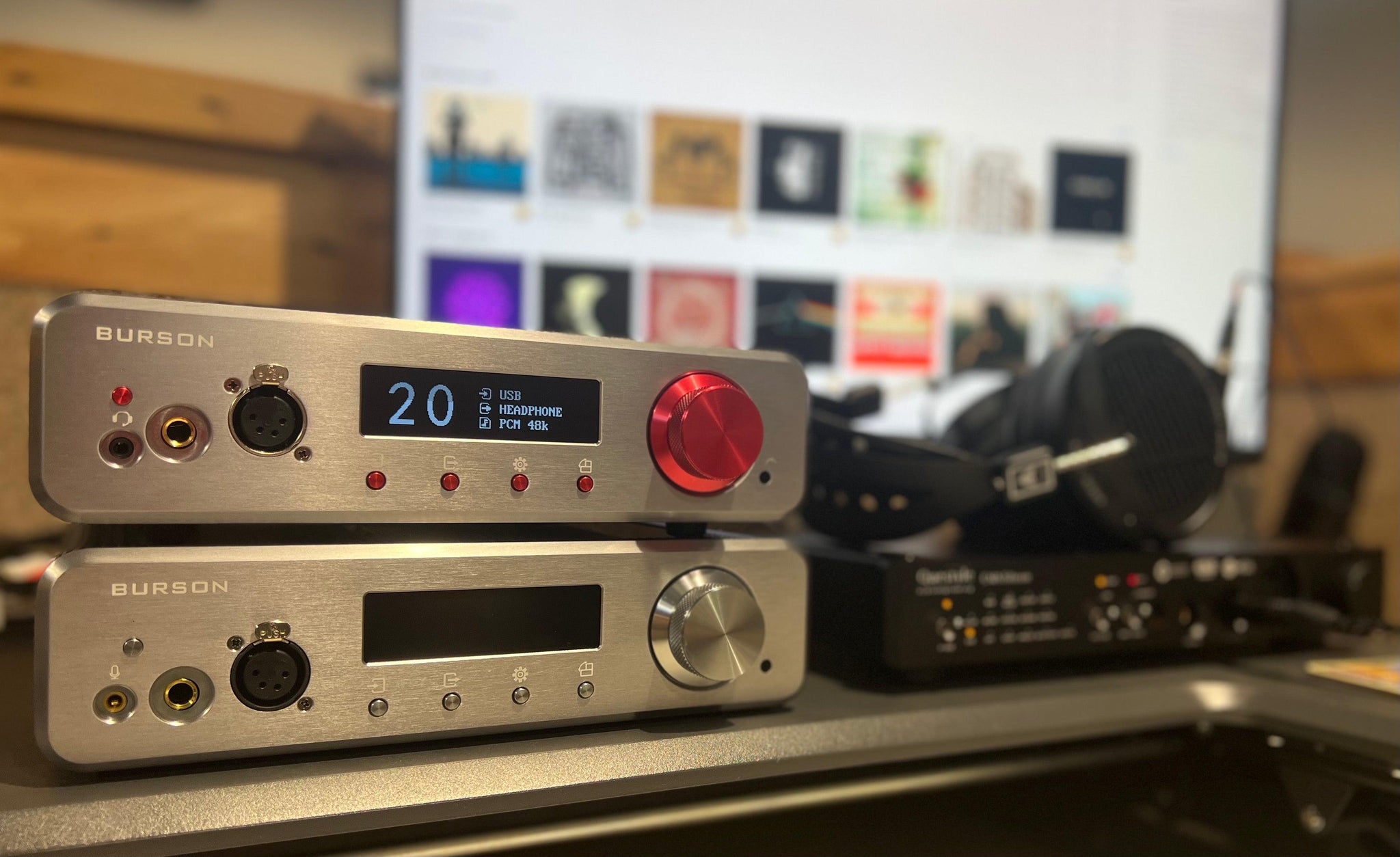Burson Audio’s GT series is all about achieving the next level in audiophile performance. As if the high powered dual-mono headphone amp Soloist 3X Grand Tourer wasn’t enough, they released dual mono blocks for all your two channel audio needs with the Timekeeper 3X GT. And now, they’ve taken the beloved Conductor 3X Reference, put some NOS in it, and made the turbocharged Conductor 3X GT. So clearly the Conductor 3X GT’s got power, but how does it handle?
Build and Design
At first glance, there isn’t anything special about the box Conductor 3X GT is packed in. It’s just a brown box that says “Conductor 3X …” and then you see it – “GRAND TOURER.” Open it up and you get the unit itself – same basic form factor as the Conductor 3X Reference – with bright red knobs and buttons, as well a case fan and the “Grand Tourer” badging to let you know that this DAC/Amp means business.
For digital inputs, you get USB, Optical, Digital Coax, and Bluetooth (5.0); and for analog you get 2 sets each of RCA and XLR. For your headphones, you get XLR, 6.3mm and a 3.5mm headset compatible jack. There are also 12V trigger jacks on the back for integrating the Conductor into your rig. The DAC and the front end of the electronics are all the same as the Reference model with some options added to accommodate the additional input and output options. That means you get the same solid frame, same smooth volume knob, and same tactile feedback from the buttons – just in red!
Sound
Conductor 3X GT is defined by its mix of a huge, powerful sound and an intense clarity and transparency. Burson has always embraced the benefits of solid state engineering and digital audio rather than trying to make the sound more “analog” or “tubey,” and Conductor 3X GT embraces that philosophy. Everything you love about solid state is here: deep bass extension, tons of power, pitch black background, and incredible transparency.
It delivers a tight, natural bass that is largely neutral, but can be deceiving. Conductor 3X GT seems to “unlock” the bass hidden in many planar magnetic headphones. While headphones like the HIFIMAN HE1000v2 or the AMT based HEDDphone might present as being light on bass on most amps – particularly on DAC/Amp combos where the amp takes a backseat to the DAC – the power it delivers gives you slam for days, along with speed and accuracy.
The midrange provides incredible detail and clarity along with a somewhat forward presentation of vocals and mid-focused instruments. In addition to providing a good degree of intimacy with the vocals, Conductor 3X GT gives guitar lovers (like myself) excellent presentation of guitar: from crisp, natural sounding acoustic guitars to incendiary leads in rock and metal. For the more cultured among us, cellos and violas have intense detail and texture, and there’s a rich reproduction of the full range of the piano.
The treble is accurate and well extended, with shimmer and air, and a just right balance between giving you a touch of emotional, physical response on the high notes – whether it’s a soprano, violin, or guitar – without giving you the sort of painful, visceral response that sharp or harsh highs can give you.
In terms of the soundstage and imaging, Conductor 3X GT creates a rounded three dimensional soundscape and delivers a vivid, lifelike image in that space. Plug into headphones with strong imaging characteristics and you get a well defined space and image.
Some of these characteristics, particularly the bass slam and soundstage, are at least somewhat related to the power. It’s giving you a max of 10W per channel (at 16 ohms), which matches the Soloist GT, though it can’t match the clean transparency of Soloist GT dual mono design at higher volumes. This means that there really isn’t a conventional headphone out there that the GT can’t handle.
Comparison: Burson Conductor 3X Reference, Questyle CMA Fifteen
If you’re shopping for a DAC/amp combo in the $2000-$3000 range with a good selection of inputs and outputs, as well as the high level of sound quality and power that should come with the price tag, the Questyle CMA Fifteen certainly comes to mind. In addition, Burson’s previous flagship DAC/amp, the Conductor 3X Reference (3XR), remains an excellent choice. Let’s take a look at how the three compare.
Questyle and Burson have very different looks for their devices in general. Burson has a more rugged design, while Questyle has a smooth, flat black finish. Where Burson gives you an LED screen for feedback and configuration, Questyle has some switches and buttons to accomplish most of the same tasks. Outside of the DAC Filter options – which Questyle doesn’t provide – the features largely match up. The one feature that Questyle provides that Burson does not is MQA support.
In terms inputs and outputs, Conductor 3XR and GT have almost the same headphone output options – 6.3mm and XLR – with the one difference being that GT has an integrated single 3.5mm plug for a headset with mic, while 3XR has a 3.5mm mic passthrough that separates the mic plug from the headphone output. CMA Fifteen adds some extra function to the proceedings with a 4.4mm along with the 6.3mm and XLR, but doesn’t have support for a mic. While the digital inputs are all about the same, Conductor 3X GT provides the most analog options, with 2 XLR and 2 RCA inputs, along with XLR and RCA output. 3XR has only XLR, but Burson does provide approved XLR to RCA adapters for the output. CMA Fifteen has XLR and RCA input, but only RCA for output.
The sound differences between Conductor 3X GT and Conductor 3XR are fairly subtle and are more notable in a side by side comparison or after having spent quite a bit of time with both units. I found GT to have stronger clarity and a wider soundstage overall but a little less upper treble. GT has more slam and depth to the sound as well. In terms of volume, GT had notably more power with the volume at 15 on GT being equal to 30 on 3XR. CMA Fifteen had more notable differences from the Burson signature sound. There’s more midbass in the CMA Fifteen which creates its own bit of extra slam. The treble is a little smoother overall, and it has a slightly more intimate sound. The power level was similar to Conductor 3XR with around one third of the CMA Fifteen’s volume equalling that 15-20 range on the Burson. CMA Fifteen demonstrated greater versatility with IEMs with its 4.4mm output and the ultra low gain mode you can activate with switches on the bottom of the unit. Even in regular operation mode, CMA Fifteen had noticeably less noise with IEMs than either Conductor model in low gain mode.
If you’re looking for unrivaled power and capabilities, along with some serious hard-driving slam, Conductor 3X GT is probably the one. The 3X Reference still gives you most of that for about a thousand bucks less and is a great value in the DAC/Amp field. If MQA is a must, you’ll be using both headphones and IEMs regularly, or if you prefer a little bit more of a musical tuning with a touch of warmth, the CMA Fifteen will give you what you need.
The Bottom Line
Following in the footsteps of the Soloist 3X GT, the Conductor 3X GT delivers next level, flagship performance. The sound quality, power, and features are all a step up from the Reference series. If you’re looking for a DAC/Amp combo under $5000 that can easily drive the most power-hungry headphones and deliver top of the line sound to top of the line headphones, Conductor 3X GT should put it at the top of your list.









